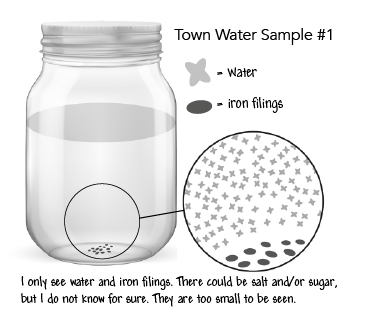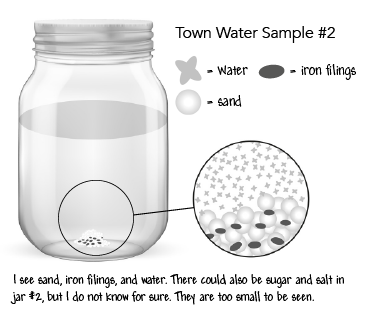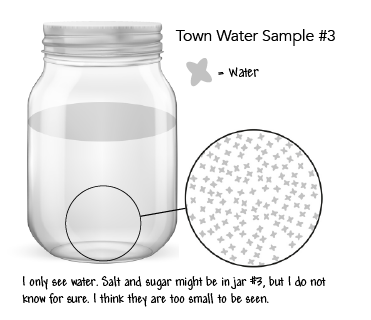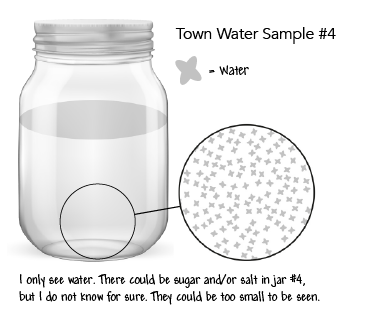






Sewage water is consumed by people, but they do not get sick.
Ask questions based on observation, then identify questions that can be investigated to identify the matter in the town water samples.
Water collected from a town may be contaminated. The town officials are requesting help to design a process that will identify the particles in the water and then clean the water.
Click here for NGSS, CCSS–ELA and Math, and California ELD standards.
This learning sequence targets engineering design; the design challenge is to design a process that will identify the particles in the water and clean the town’s water supply.
This lesson is the first in the sequence and is designed to activate students’ prior experience with contaminated water, elicit their questions about contamination from observations of a video and actual water samples, and generate investigation questions that will drive their learning through the next set of lessons. This lesson introduces the identified problem: Water collected from a town may be contaminated. The town officials are requesting help to design a process that will identify the particles in the water and then clean the water. In order to do this, students, throughout the learning sequence, will build on their prior knowledge that matter is made of particles too small to be seen, but even so, the matter can be detected by other means.
In Lesson 2: Finding Impurities in Water, students will investigate how the quantity of matter in the water impacts its contamination level.
Throughout the lesson, a flag ( ) denotes formative assessment opportunities where you may change instruction in response to students’ level of understanding and making sense of phenomena.
) denotes formative assessment opportunities where you may change instruction in response to students’ level of understanding and making sense of phenomena.
| Part I | 20 minutes | Engage |
| Part II | 45 minutes | Engage |
| Part III | 45 minutes | Engage |
This entire lesson is an Engage, designed to elicit students’ prior knowledge, gather their wonderings about contaminated water, and encourage them to think about questions they would like to investigate. Student ideas should be recorded, but not challenged or corrected during this lesson.
Ask questions that can be investigated to identify the types and quantity of matter, including very small and unseen matter, in the town water samples.
For guidance on creating question boards, see Jordine, Jeff and Ruben Torres: “Enhancing Science Kits with the Driving Question Board” Science and Children April/May 2013; pages 57–61.
For reluctant writers, suggest students draw a picture of their experience/memory. If a student seems stuck, ask if they would drink water from a puddle outside the classroom, a lake, or a stream. Is the water safe to drink? Why or why not?
Ask questions that can be investigated to identify the types and quantity of matter, including very small and unseen matter, in the town water samples.
The students will return to 5.1.H1: Town Water Samples in Step 12 where they will revise their models after they gather additional information.
If students need scaffolding on asking questions, ask them what observations will reveal more information. You want to lead students to ask questions that can be investigated.
There are many types of questions students can ask. This lesson focuses on investigation questions rather than testable questions. The term investigation is the broadest category of inquiry; an experiment is a special kind of investigation in which variables are identified and tested to determine cause-and-effect relationships. Investigation questions are often answered by reading, research, or making observations.
Students may generate testable questions in this lesson (e.g., what is the effect of the contaminant on the cloudiness of the water?). In Step 13, student will sort out these questions to be addressed at another time.




If there were no questions about the “unseen” particles in the first set of wonderings, their refined model should now have some representation of the unknown matter in the water such as what the contaminants are, how much is present, etc. Students should now have questions about those particles.
If students are still having trouble thinking about unseen matter in the water, demonstrate for the group. Take a glass of water, add a small amount of salt or sugar, and stir until dissolved. Ask, “Can you see the salt/sugar in the water? How would anyone know it is there?”
 After the lesson, collect 5.1.H1: Town Water Samples as a formative assessment to gather information to direct future lessons and provide students with feedback on the expectations for drawing a model. Assess students’ application of PS1.A to see if they can use prior knowledge about the particulate nature of matter. If a student model does not include “other” particles such as sugar, salt, iron, etc. for at least jars #1, #2, and #3, remind them of the story and the samples of these materials they looked at.
After the lesson, collect 5.1.H1: Town Water Samples as a formative assessment to gather information to direct future lessons and provide students with feedback on the expectations for drawing a model. Assess students’ application of PS1.A to see if they can use prior knowledge about the particulate nature of matter. If a student model does not include “other” particles such as sugar, salt, iron, etc. for at least jars #1, #2, and #3, remind them of the story and the samples of these materials they looked at.
Ask questions that can be investigated to identify the types and quantity of matter, including very small and unseen matter.
This learning sequence specifically targets the problem of material in the water and the process of removing it. Students may have questions about preventing the contamination of water. If so, create that category for the Class Question Board. If students do not yet have these questions, it is likely that they will over the course of the sequence, and the category can be added at that time. Water protection and preservation are not addressed explicitly in this learning sequence, but these questions help students realize problems that may exist within the larger system. These issues within the system can be added as an extension or differentiation strategy at the end of the learning sequence.
60 minutes. (2018, April 29). Drink filtered sewage water. Retrieved from https://www.youtube.com/watch?v=sQBfCh-vmsw
Jordine, J., & Torres, R. (2013). Enhancing Science Kits with the Driving Question Board. Science and Children, April/May, 57–61.
Michaels, S., & O’Conner, C. (2012). The Inquiry Project’s Talk Science Primer. Retrieved from https://inquiryproject.terc.edu/shared/pd/TalkScience_Primer.pdf
Schwarz, C. V., Passmore, C., & Reiser, B. J. (2017). Helping students make sense of the world using next generation science and engineering practices. Arlington, VA: NSTA Press, National Science Teachers Association.